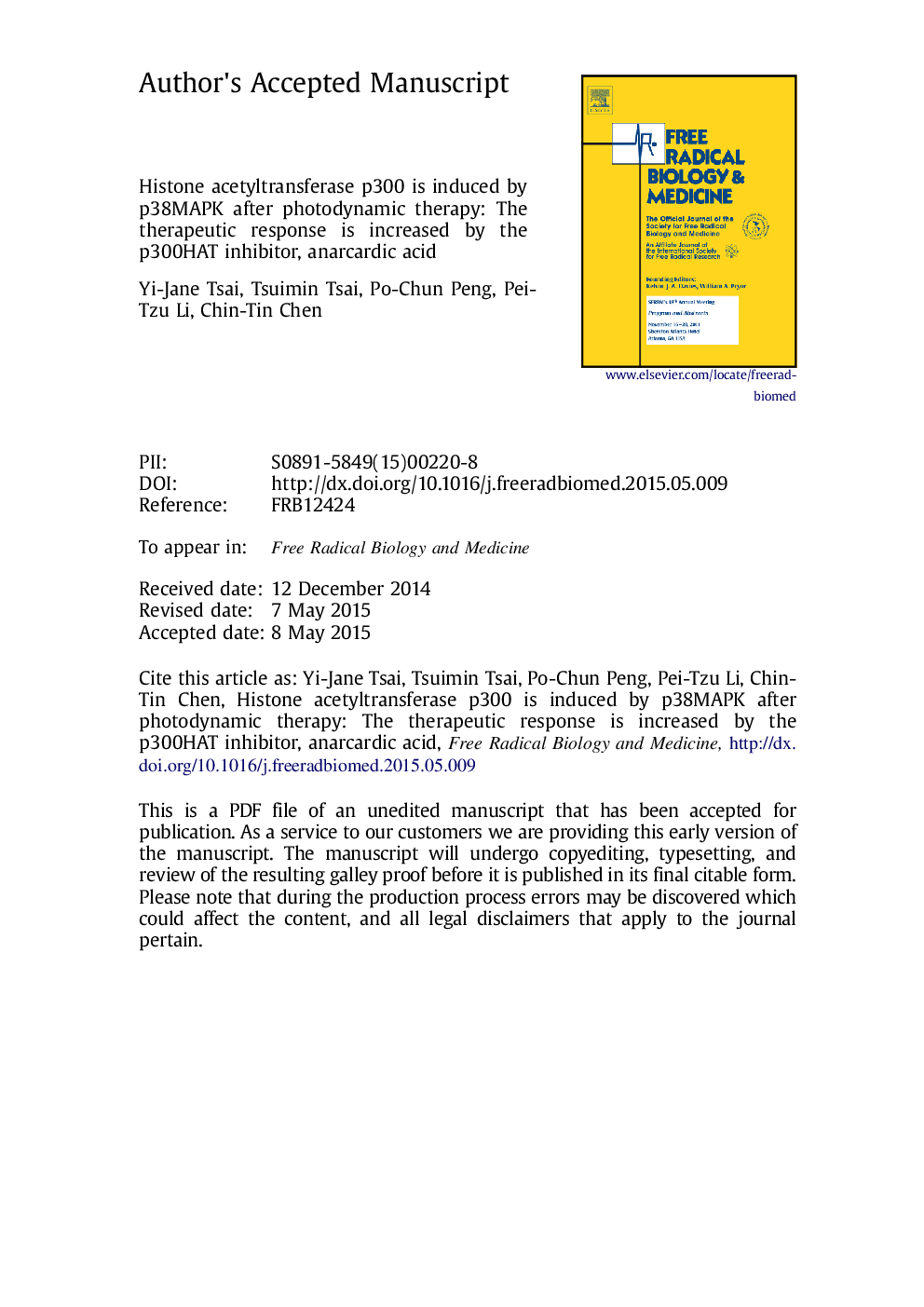| کد مقاله | کد نشریه | سال انتشار | مقاله انگلیسی | نسخه تمام متن |
|---|---|---|---|---|
| 8268941 | 1534956 | 2015 | 46 صفحه PDF | دانلود رایگان |
عنوان انگلیسی مقاله ISI
Histone acetyltransferase p300 is induced by p38MAPK after photodynamic therapy: the therapeutic response is increased by the p300HAT inhibitor anacardic acid
دانلود مقاله + سفارش ترجمه
دانلود مقاله ISI انگلیسی
رایگان برای ایرانیان
کلمات کلیدی
RT-PCRZ-VAl-Ala-Asp-fluoromethylketoneHistone H3 acetylationp38MAPKSurvivinPARPALAHDACERKCe6COX-2NACshRNAJnkDMEMPBSNF-κBFBS5-Aminolevulinic acid - 5-آمینولولولینیک اسیدc-Jun N-terminal kinase - C-Jun N-terminal kinaseDulbecco's modified Eagle's medium - Medal of Eagle اصلاح شده DulbeccoMTT - MTTN-acetylcysteine - N-استیل سیستئینshort hairpin RNA - RNA موی سر کوتاهz-VAD-fmk - Z-VAD-FMKHistone acetylation - استیلیت هیستونAnacardic acid - اسید آناکاردیکchromatin immunoprecipitation - ایمن سازی کروماتینintraperitoneal injection - تزریق داخل صفاقیIntravenous injection - تزریق داخل وریدیPhotodynamic therapy - درمان فتودینامیکfetal bovine serum - سرم جنین گاوCyclooxygenase-2 - سیکلوکوکسیژناز2nuclear factor-κB - فاکتور هسته ای κBPhosphate-buffered saline - محلول نمک فسفات با خاصیت بافریHistone acetyltransferase - هیستون استیل ترانسفرازhistone deacetylase - هیستون داستیلازreverse transcription-polymerase chain reaction - واکنش زنجیره ای رونویسی-پلیمراز معکوسp38 mitogen-activated protein kinase - پروتئین کیناز متیوژن فعال p38CHiP - چیپHAT - کلاهChlorin e6 - کلرین e6extracellular-signal-regulated kinase - کیناز تنظیم شده خارج سلولی سیگنال
موضوعات مرتبط
علوم زیستی و بیوفناوری
بیوشیمی، ژنتیک و زیست شناسی مولکولی
سالمندی
پیش نمایش صفحه اول مقاله

چکیده انگلیسی
Oxidative stress mediated by photodynamic therapy (PDT) mediates the tumoricidal effect, but has also been shown to induce the expression of prosurvival molecules, such as cyclooxygenase-2 (COX-2), which is involved in tumor recurrences after PDT. However, the molecular mechanism is still not fully understood. In this study, we found that activated p38MAPK could significantly up-regulate the activity and expression of histone acetyltransferase p300 (p300HAT) in A375 and C26 cells treated with ALA-and chlorin e6 (Ce6)-mediated photodynamic treatment. A colony-formation assay showed that PDT-induced cytotoxicity was dramatically elevated in the presence of the p300HAT inhibitor anacardic acid (AA). Further studies showed that increased p300HAT acetylates histone H3 and NF-κB p65 subunit to up-regulate the COX-2 expression, which was reduced by AA or p300HAT shRNA. Using chromatin immunoprecipitation analysis, we found that the augmented acetylation of histone H3 and NF-κB increases their binding to the COX-2 promoter region. These in vitro findings were further verified in mice bearing murine C26 and human A375 tumors treated with liposomal Ce6 mediated PDT. Meanwhile, the combination of PDT and AA resulted in greater tumor regression in BALB/c mice bearing C26 tumors, compared with PDT only or combined with COX-2 inhibitor. Finally, we demonstrated that suppression of the PDT-induced p300HAT activity also resulted in the decreased expression of survivin, restoring caspase-3 activity and sensitizing PDT-treated cells from autophagy to apoptosis due to the Becline-1 cleavage. This study demonstrates for the first time the molecular mechanisms involved in histone modification induced by PDT-mediated oxidative stress, suggesting that HAT inhibitors may provide a novel therapeutic approach for improving PDT response.
ناشر
Database: Elsevier - ScienceDirect (ساینس دایرکت)
Journal: Free Radical Biology and Medicine - Volume 86, September 2015, Pages 118-132
Journal: Free Radical Biology and Medicine - Volume 86, September 2015, Pages 118-132
نویسندگان
Yi-Jane Tsai, Tsuimin Tsai, Po-Chun Peng, Pei-Tzu Li, Chin-Tin Chen,